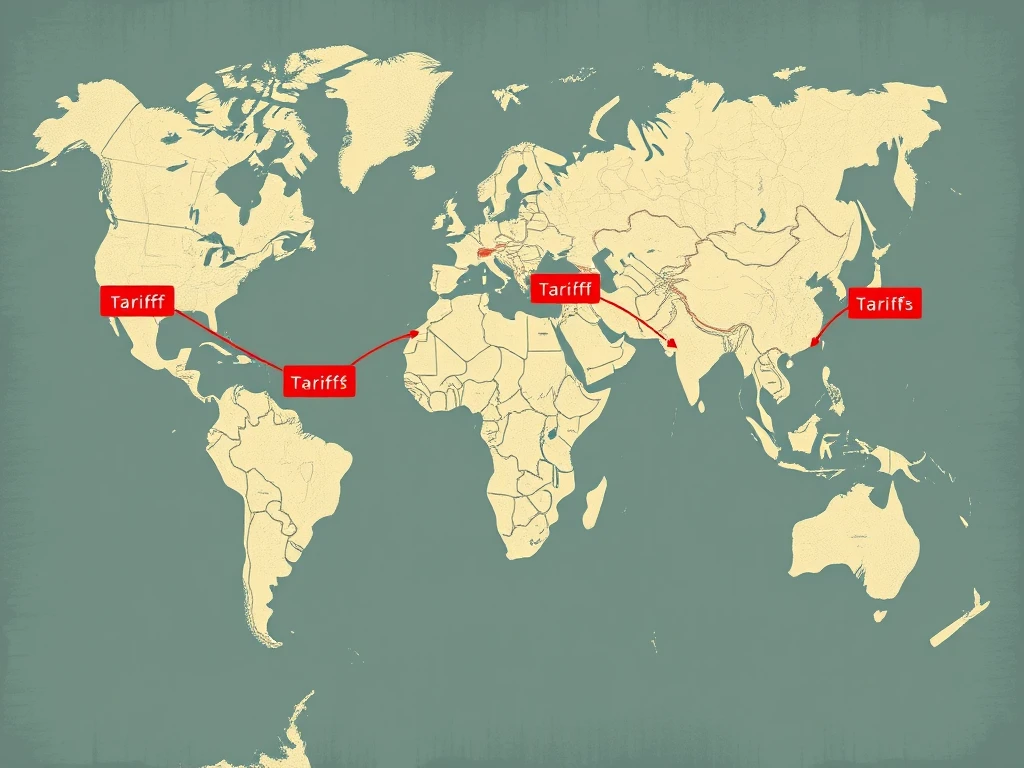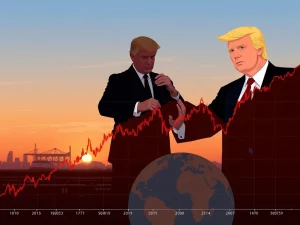Unveiling Tariffs: The Shocking Truth About Global Trade and Your Investments

Ever wondered how taxes on imported goods could ripple through the global economy and even impact your crypto portfolio? Let’s break down the complex world of tariffs and understand why they’re making headlines and shaping the future of international trade. It’s not just about economics; it’s about power, strategy, and how it all trickles down to your investments.
Decoding Tariffs: What Exactly Are They?
Simply put, tariffs are taxes imposed by governments on goods imported from other countries. Think of them as border taxes designed to generate revenue, regulate trade, and protect domestic industries. While occasionally applied to exports, they’re primarily used to control imports. Let’s categorize the main types of tariffs to get a clearer picture:
- Ad valorem tariffs: These are calculated as a percentage of the imported good’s value. For example, a 15% ad valorem tariff on a $200 imported gadget means a $30 tax.
- Specific tariffs: These are fixed fees based on the quantity of imported goods, irrespective of value. A $2 tariff per imported t-shirt is a specific tariff.
- Compound tariffs: A combination of both specific and ad valorem tariffs on the same goods. Imagine a tariff on imported whiskey that’s $1 per bottle plus 5% of its value.
- Mixed tariffs: These tariffs apply either a specific duty or an ad valorem duty, whichever is higher, based on predefined conditions. For instance, on imported leather bags, it might be $10 per bag or 20% of the bag’s value, whichever results in a larger tax.
Governments use these tools to influence global markets and protect their home-grown industries from foreign competition. By increasing the cost of imported goods, tariffs can make domestically produced items more attractive price-wise for consumers.
The Trump Era and Reciprocal Tariffs: A Game Changer?
The Trump administration heavily utilized reciprocal tariffs as a key strategy to reshape international trade. But what are they exactly? Reciprocal tariffs are essentially retaliatory trade duties. If Country A imposes a tariff on goods from Country B, then Country B might respond by imposing reciprocal tariffs on goods from Country A. This tit-for-tat approach aims to correct perceived trade imbalances and safeguard domestic industries.
President Trump’s executive order in April 2025, imposing a minimum 10% tariff on all US imports, dramatically escalated this approach. He further introduced reciprocal tariffs, stating the US would apply tariffs at roughly half the rate imposed by other countries. For instance, a 34% US tariff in response to China’s 67%. A significant 25% tariff on all automobile imports was also announced.
The rationale behind this economic policy was to address what the administration viewed as long-standing trade imbalances and unfair treatment of the US by its trading partners. The aim was to pressure other nations to lower their trade barriers and renegotiate trade deals. While this resonated with domestic manufacturers and labor unions seeking to revitalize US industry, it sparked considerable criticism from economists and international allies who warned against protectionism and the destabilization of the global economic order.
Did you know? Tariffs can drastically alter supply chains. To dodge high import taxes, companies often relocate manufacturing to countries with more favorable trade agreements. However, these savings aren’t always passed down to consumers, and the complexities of logistics can increase.
US–China Trade War: An Economic Showdown
The US–China trade war, commencing in 2018, became a defining moment in global economic history. This conflict between the world’s two largest economies sent shockwaves through global supply chains, fueled inflation concerns, and reshaped geopolitical dynamics. It wasn’t just a bilateral dispute; it signaled a fundamental shift in trade policy in an increasingly multipolar world.
The trade war began with the US imposing tariffs under Section 301 of the Trade Act of 1974, citing unfair trade practices, intellectual property theft, and forced technology transfers by China. The scale was massive: tariffs were levied on over $360 billion worth of Chinese goods. China retaliated with tariffs on $110 billion of US exports, targeting key sectors like agriculture and manufacturing.
American farmers faced severe repercussions due to retaliatory Chinese tariffs on soybeans, leading to billions in US government subsidies to mitigate losses. While the Phase One Agreement in 2020 offered some respite, many tariffs remained. The Biden administration largely maintained these measures, reflecting a bipartisan consensus on concerns regarding China’s trade practices.
As of April 10, 2025, Trump had imposed substantial 125% tariffs on China, while offering a 90-day pause for tariffs on 75 other countries. The stakes and consequences in the US-China conflict dwarfed disputes with allies like the EU or Canada.
Here’s a snapshot of global reactions to Trump’s tariffs:
| Government | Response |
|---|---|
| Canadian Prime Minister Mark Carney | Implemented a 25% tariff on US-made cars and trucks. |
| China | Imposed a 34% tariff on all US imports, effective April 10. |
| French Prime Minister | Described the tariffs as an economic catastrophe. |
| Italian Prime Minister Giorgia Meloni | Criticized the tariffs as wrong. |
| European Commission chief Ursula von der Leyen | Pledged a unified response and prepared countermeasures. |
| Taiwan’s government | Denounced the tariffs as unreasonable. |
How Tariffs Impact You: The Ripple Effect
When a tariff, say 20% on imported electronics, is applied, it immediately increases the cost for importers. These added costs are then passed down the line – to businesses, and ultimately, to consumers. Let’s break down the impact:
- Importers: Face higher purchase costs, potentially reducing profit margins or forcing them to seek cost-effective alternatives.
- Exporters: May suffer as US buyers reduce orders due to increased prices, diminishing their competitiveness in the US market.
- Domestic Producers: Can initially benefit from reduced foreign competition, potentially increasing sales and profits. However, if they rely on imported components subject to tariffs, their input costs might also rise.
- Consumers: Often bear the biggest burden through price increases on everyday goods, from electronics to clothing, contributing to inflation and reduced purchasing power in the long run.
Tariffs also disrupt global supply chains. With products often assembled from components sourced from multiple countries, tariffs on even one component can cause delays, force redesigns, or prompt companies to relocate manufacturing, adding complexity and costs throughout the system. In essence, while tariffs aim to protect domestic industries, their effects are widespread, impacting prices, trade dynamics, and business strategies across the board.
Interestingly, Trump strategically excluded certain tech products like smartphones, chips, and computers from reciprocal tariffs, providing crucial relief to the tech sector and easing pressure on tech stocks. However, the initial tariff announcement on April 2 triggered a sharp sell-off in both equities and Bitcoin (BTC), with BTC plunging 10.5% in a week. This highlighted Bitcoin’s increasing correlation with tech stocks and its sensitivity to macroeconomic shocks, as institutional investors increasingly view BTC as a risk-on asset tied to policy shifts.
Did you know? Tariff exemptions can be highly strategic tools. Governments may exempt specific industries or companies, allowing them tariff-free imports while competitors face higher costs, creating uneven playing fields and domestic controversy.
Why Tariffs Are a Big Deal for Global Markets?
Tariffs are powerful instruments for governments to sculpt a nation’s economic and trade strategy. They’re not just taxes; they’re tools that shape domestic production, consumer behavior, and international trade relationships. For a major player like the US, tariffs have historically been used to project economic power, protect nascent industries, and respond to perceived unfair trade practices.
When large economies deploy tariffs, the impact on global markets is significant. Supply chains can be rerouted, manufacturing hubs can shift, and the prices of goods worldwide can fluctuate. Even for smaller nations in our interconnected world, tariffs matter profoundly as their effects extend far beyond national borders.
Domestically, tariffs might provide a short-term boost to local industries by making foreign goods pricier, potentially creating jobs and bolstering economic resilience. Governments also gain revenue from tariffs, which could, in theory, allow for reductions in direct taxes, as Trump proposed. However, the downsides include increased consumer prices, harm to exporters, and the risk of retaliatory measures from trade partners.
In an era of rising geopolitical tensions and nations re-evaluating economic dependencies, tariffs have resurfaced as a central element of US economic policy. Whether used defensively or offensively, they redefine the balance between protectionism and global engagement, making them a critical issue of national strategy and global influence.
Who Sets Tariff Policy in the US? The Power Players
US tariff policy is a result of interactions between legislative authority, executive power, and administrative enforcement. Congress holds the constitutional power to regulate trade and impose tariffs. However, over time, Congress has delegated significant authority to the president to modify tariffs in response to national security concerns, economic threats, or trade violations.
The Office of the US Trade Representative (USTR) is pivotal in formulating and negotiating US trade policy. It leads trade negotiations, manages trade disputes, and recommends tariff actions, often in close collaboration with the president and Congress. US Customs and Border Protection (CBP) is the agency responsible for enforcing tariffs at ports of entry, collecting duties based on the classification and declared value of imported goods according to the Harmonized Tariff Schedule.
Several key trade laws have shaped US tariff policy. The Smoot-Hawley Tariff Act of 1930, intended to protect US farmers during the Great Depression, ironically triggered retaliatory tariffs and worsened the global trade situation. Later, the Trade Act of 1974 granted the president tools like Section 301, which was extensively used during the US-China trade war to impose retaliatory tariffs against unfair foreign practices.
Criticism of Trump’s Tariff Policy: Dissenting Voices
Trump’s tariff policy faced significant criticism, particularly regarding the introduction of reciprocal tariffs. Critics argued that this approach circumvented Congress and established a risky precedent for unchecked executive power in economic matters. Many argued that these tariffs harmed American businesses more than their intended foreign targets.
A Vox article highlighted concerns that low-income individuals would disproportionately bear the brunt of Trump’s tariffs. Former Treasury Secretary Lawrence Summers warned of a potential recession triggered by tariffs, potentially costing millions of jobs. Legal challenges also emerged. The New Civil Liberties Alliance (NCLA) filed a lawsuit on behalf of a small business, Simplified, arguing that the president exceeded his authority under the International Emergency Economic Powers Act (IEEPA) by imposing tariffs in a non-emergency trade context.
Small and medium-sized businesses, heavily reliant on global supply chains, faced rising import costs due to tariffs, potentially leading to inflation and reduced competitiveness. While the tariffs might inflict short-term financial pain on China, the long-term consequences could include higher prices for US consumers and operational disruptions for American firms if the policy persists.
In Conclusion: Tariffs – A Double-Edged Sword in Global Trade
Tariffs are a potent instrument in international trade, wielding the power to reshape economies, influence global markets, and alter the course of economic policy. While they can be strategically employed to protect domestic industries and address unfair trade practices, their implementation is fraught with complexities and potential repercussions. The Trump administration’s era of reciprocal tariffs and the US-China trade war vividly illustrate the far-reaching consequences of tariff-driven policies, impacting everything from consumer prices to geopolitical relations and even the volatile crypto market. Understanding tariffs is no longer just for economists; it’s crucial for anyone navigating today’s interconnected and often turbulent economic landscape.








